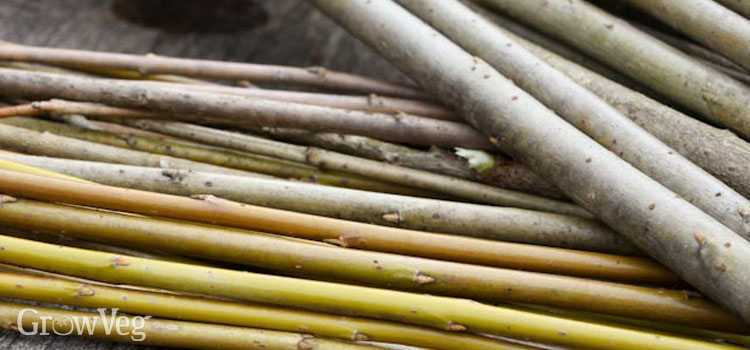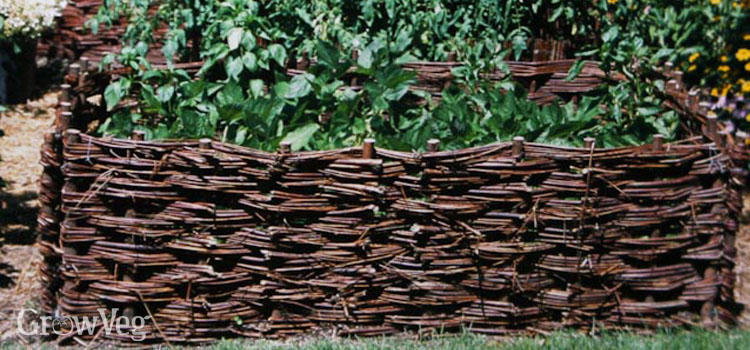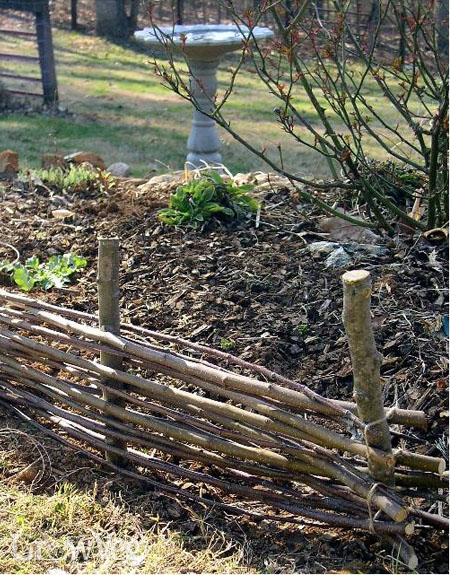what happens to the dry twigs in a wattle fence
Weaving Wood: Twig Towers and Wattle Fences

Pruning flavor is here, which means that many of united states volition quickly accumulate a small-scale mountain of superfluous sticks. At my house, many pruned branches are given a second life as woven wattle fences, institute supports, and twig towers for growing vines in containers. If you've itched to brand natural structures for your garden, pruning season is the best time to try.
Look to be successful, because you will exist practicing a edifice art used in tree-rich terrains effectually the world for more than 6,000 years. Today, exercising your creative muscles by weaving wood into fences, trellises or other plant supports will consequence in beautiful, functional items for your garden that are free for the making.

Best Woods for Weaving
Hardwood trees produce strong wood that is difficult to bend, only small, straight pieces of whatsoever woods tin can be used for posts, as shown in the low contend at right. For the horizontals I used the longest sprouts saved from apple pruning.
Indeed, it has been my experience that equally long as the sprouts or whips are just one twelvemonth sometime, even maple makes a expert forest for weaving when used fresh. The peas in a planter (see photo) were supported past hoops and stakes provided by a maple stump that produced a flush of sprouts every year. Rather than curse them, I put them to practiced employ.
Serious wood weavers are attracted to species known for their usefulness and productivity. Common hazel, Corylus avellana, will mature into a multi-stemmed tree, 15 to 20 feet (v to six one thousand) tall when allowed to grow freely. Simply when cutting back close to the ground (coppiced) every few years, the directly stems that regrow are unsurpassed for making long-lasting wattle fences.

Willows used for basket-making (Salix purpurea and other Salix species) are quite pliable afterwards the osiers (long, slender sticks) accept been soaked in water for a few hours. I grow a few basketry willows myself, and they have proven to exist very depression-care plants that produce an abundance of rods and osiers for making twig towers – my favorite project involving weaving wood, explained in more detail below. If you take plenty of material, willow sculpture is a possibility for ambitious weavers of wood.
Ane of the best things about willow is that y'all can harvest, sort and store the branches in a dry out identify, and so they are gear up to use in any flavor. A long soak in water is required to restore their pliability, only having a store of willow on paw makes it possible to craft natural garden structures in any season of the yr.

Making Twig Towers and Wattle Fences
One of the best projects for beginners is a twig belfry, which is constructed in a large flowerpot or planter at to the lowest degree fourteen inches (35 cm) wide, filled with potting soil. First nine or more upright rods are inserted around the inside edges of the pot and fastened together at the top with wire or string. And then, a spreader ring made from wire or wood is pushed upwardly within the tower as far as it will go and fastened in place. The spreader ring exerts force per unit area on the uprights that pushes them against the inside walls of the container. Afterwards more than slender osiers and bits of vine are woven around the belfry, it becomes surprisingly stable. I usually keep new twig tower in its container the first year, and gently elevator information technology out and motion it to the garden for a second season of utilize. Then it becomes compost.
A tightly woven wattle fence panel, or hurdle, tin can last a little longer if information technology is pulled up and stored through wintertime. Valuable for blocking wind, shading roots, and screening views, woven wattle hurdles can exist permanent or portable. The permanent version is easiest to make, because you just pound about five stakes into the basis and starting time weaving osiers, keeping the weave as tight as y'all tin. To make a console you can move, make a runner board for the base of operations, with holes drilled through it for the upright stakes.

Whether permanent or portable, it is easier to fasten together small hurdles than to create very long ones.
Simply why not start small-scale? Put a few small sticks to work equally wickets to protect plants from adventitious injury. Tie together pruned grape vines to make a rustic wreath. Next matter you know, you lot will be making 1-of-a-kind natural structures for your garden that piece of work as good as they await.
By Barbara Pleasant
< All Guides
Source: https://www.growveg.com/guides/weaving-wood-twig-towers-and-wattle-fences/
0 Response to "what happens to the dry twigs in a wattle fence"
Post a Comment